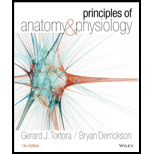
Which components of the
To review:
The gastrointestinal (GI) tract organs as well as accessory digestive organs.
Introduction:
Digestion is the process, by which the larger food particles are broken down into smaller absorbable molecules. This system consists of GI tract (alimentary canal) and the accessory organs.
Explanation of Solution
The digestive system is divided into two major subdivisions:
GI tract
Accessory organs
The organs of the alimentary canal are pharynx, mouth, stomach, esophagus, and small as well as large intestines. The GI tract is a long tube-like structure that spans from the mouth up to the anus. The accessory digestive organs include the salivary glands, teeth, gallbladder, tongue, pancreas, and liver. The functions of different digestive system's organs are described below:
The mouth is the opening of the alimentary canal. Food enters the digestive tract via the mouth. Mouth consists of the salivary glands, teeth, and the tongue. Salivary glands secrete saliva that helps in the digestion of carbohydrates. Teeth and tongue help in the mastication of food. Then the food goes into the esophagus, through which the food enters the stomach. Peristaltic movements (rhythmic contractions and relaxations) in the esophagus enable food to move into the stomach.
The stomach is a muscular bag, which is involved in the hydrolysis of protein. It releases pepsin for protein digestion and also secretes hydrochloric acid to make the food acidic so that the intestinal enzymes can act on it.
The small intestine is where the digestion ends. It has three subdivisions namely, duodenum followed by jejunum and lastly the ileum. It receives secretions from the liver and the pancreas that digest the food further. This is where the food components are absorbed via the villi in the small intestine.
The large intestine is usually involved in the absorption of water and nutrients by the body. The subdivisions of the large intestine are rectum, cecum, colon, anal canal, and appendix. Other digestive organs include pancreas, gallbladder, and liver.
Thus, the different digestive organs include organs of the alimentary canal and the accessory organs. These organs work together to break down the large food particles into smaller absorbable molecules. These molecules are then absorbed in the blood and thus, the energy and nutrition are supplied to different body tissues.
Want to see more full solutions like this?
Chapter 24 Solutions
Principles of Anatomy and Physiology
Additional Science Textbook Solutions
Genetics: From Genes to Genomes
Applications and Investigations in Earth Science (9th Edition)
Campbell Essential Biology (7th Edition)
Laboratory Manual For Human Anatomy & Physiology
- What symbolic and cultural behaviors are evident in the archaeological record and associated with Neandertals and anatomically modern humans in Europe beginning around 35,000 yBP (during the Upper Paleolithic)?arrow_forwardDescribe three cranial and postcranial features of Neanderthals skeletons that are likely adaptation to the cold climates of Upper Pleistocene Europe and explain how they are adaptations to a cold climate.arrow_forwardBiology Questionarrow_forward
- ✓ Details Draw a protein that is embedded in a membrane (a transmembrane protein), label the lipid bilayer and the protein. Identify the areas of the lipid bilayer that are hydrophobic and hydrophilic. Draw a membrane with two transporters: a proton pump transporter that uses ATP to generate a proton gradient, and a second transporter that moves glucose by secondary active transport (cartoon-like is ok). It will be important to show protons moving in the correct direction, and that the transporter that is powered by secondary active transport is logically related to the proton pump.arrow_forwarddrawing chemical structure of ATP. please draw in and label whats asked. Thank you.arrow_forwardOutline the negative feedback loop that allows us to maintain a healthy water concentration in our blood. You may use diagram if you wisharrow_forward
- Give examples of fat soluble and non-fat soluble hormonesarrow_forwardJust click view full document and register so you can see the whole document. how do i access this. following from the previous question; https://www.bartleby.com/questions-and-answers/hi-hi-with-this-unit-assessment-psy4406-tp4-report-assessment-material-case-stydu-ms-alecia-moore.-o/5e09906a-5101-4297-a8f7-49449b0bb5a7. on Google this image comes up and i have signed/ payed for the service and unable to access the full document. are you able to copy and past to this response. please see the screenshot from google page. unfortunality its not allowing me attch the image can you please show me the mathmetic calculation/ workout for the reult sectionarrow_forwardIn tabular form, differentiate between reversible and irreversible cell injury.arrow_forward
 Human Physiology: From Cells to Systems (MindTap ...BiologyISBN:9781285866932Author:Lauralee SherwoodPublisher:Cengage Learning
Human Physiology: From Cells to Systems (MindTap ...BiologyISBN:9781285866932Author:Lauralee SherwoodPublisher:Cengage Learning Human Biology (MindTap Course List)BiologyISBN:9781305112100Author:Cecie Starr, Beverly McMillanPublisher:Cengage Learning
Human Biology (MindTap Course List)BiologyISBN:9781305112100Author:Cecie Starr, Beverly McMillanPublisher:Cengage Learning Concepts of BiologyBiologyISBN:9781938168116Author:Samantha Fowler, Rebecca Roush, James WisePublisher:OpenStax College
Concepts of BiologyBiologyISBN:9781938168116Author:Samantha Fowler, Rebecca Roush, James WisePublisher:OpenStax College





